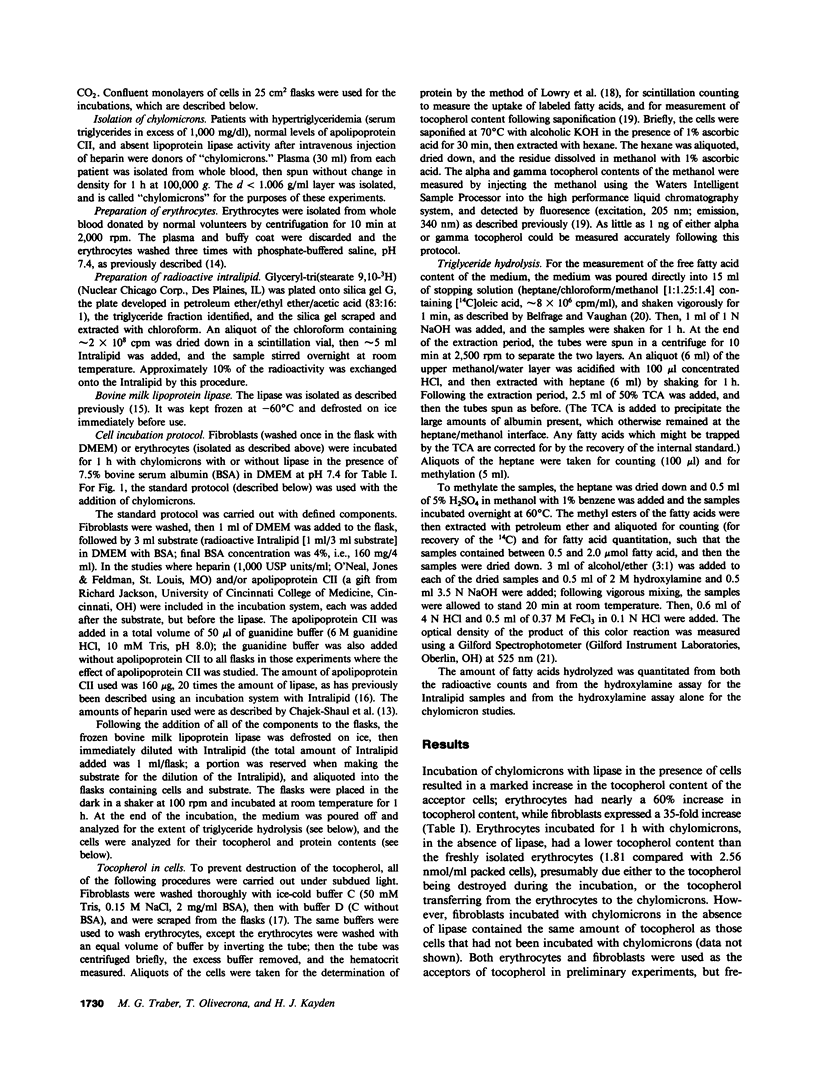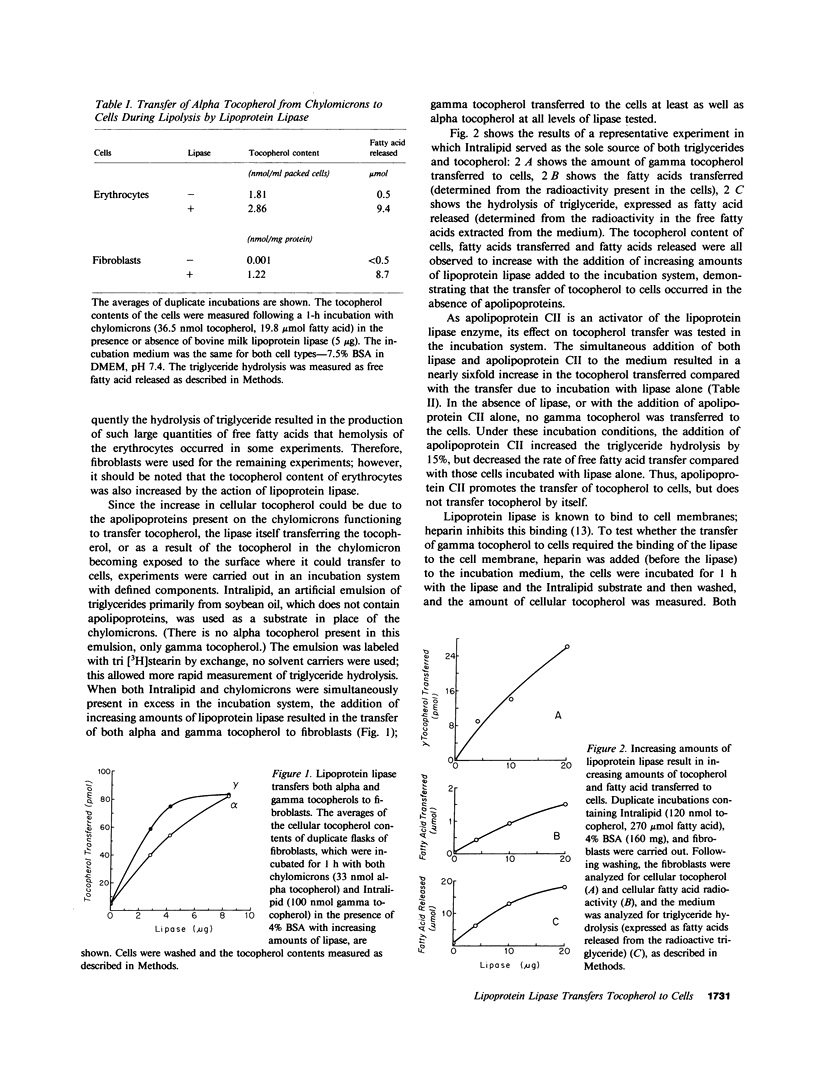Abstract
Lipoprotein lipase appears to function as the mechanism by which dietary vitamin E (tocopherol) is transferred from chylomicrons to tissues. In patients with lipoprotein lipase deficiency, more than 85% of both the circulating triglyceride and tocopherol is contained in the chylomicron fraction. The studies presented here show that the in vitro addition of bovine milk lipoprotein lipase (lipase) to chylomicrons in the presence of human erythrocytes or fibroblasts (and bovine serum albumin [BSA]) resulted in the hydrolysis of the triglyceride and the transfer of both fatty acids and tocopherol to the cells; in the absence of lipase, no increase in cellular tocopherol was detectable. The incubation system was simplified to include only fibroblasts, BSA, and Intralipid (an artificial lipid emulsion containing 10% soybean oil, which has gamma but not alpha tocopherol). The addition of lipase to this system also resulted in the transfer of tocopherol (gamma) to the fibroblasts. Addition of both lipase and its activator, apolipoprotein CII, resulted in a further increase in the cellular tocopherol content, but apolipoprotein CII alone had no effect. Heparin, which is known to prevent the binding of lipoprotein lipase to the cell surface membrane, abrogated the transfer of tocopherol to fibroblasts without altering the rate of triglyceride hydrolysis. Thus, in vitro tocopherol is transferred to cells during hydrolysis of triglyceride by the action of lipase, and for this transfer of tocopherol to occur, the lipase itself must bind to the cell membrane.
Full text
PDF





Selected References
These references are in PubMed. This may not be the complete list of references from this article.
- Belfrage P., Vaughan M. Simple liquid-liquid partition system for isolation of labeled oleic acid from mixtures with glycerides. J Lipid Res. 1969 May;10(3):341–344. [PubMed] [Google Scholar]
- Bengtsson G., Olivecrona T. Interaction of lipoprotein lipase with heparin-Sepharose. Evaluation of conditions for affinity binding. Biochem J. 1977 Oct 1;167(1):109–119. doi: 10.1042/bj1670109. [DOI] [PMC free article] [PubMed] [Google Scholar]
- Bengtsson G., Olivecrona T. On the pH dependency of lipoprotein lipase activity. Biochim Biophys Acta. 1982 Jul 20;712(1):196–199. doi: 10.1016/0005-2760(82)90102-3. [DOI] [PubMed] [Google Scholar]
- Bjornson L. K., Kayden H. J., Miller E., Moshell A. N. The transport of alpha-tocopherol and beta-carotene in human blood. J Lipid Res. 1976 Jul;17(4):343–352. [PubMed] [Google Scholar]
- Chajek-Shaul T., Friedman G., Stein O., Olivecrona T., Stein Y. Binding of lipoprotein lipase to the cell surface is essential for the transmembrane transport of chylomicron cholesteryl ester. Biochim Biophys Acta. 1982 Jul 20;712(1):200–210. doi: 10.1016/0005-2760(82)90103-5. [DOI] [PubMed] [Google Scholar]
- Fielding C. J. Metabolism of cholesterol-rich chylomicroms. Mechanism of binding and uptake of cholesteryl esters by the vascular bed of the perfused rat heart. J Clin Invest. 1978 Jul;62(1):141–151. doi: 10.1172/JCI109099. [DOI] [PMC free article] [PubMed] [Google Scholar]
- Guggenheim M. A., Ringel S. P., Silverman A., Grabert B. E., Neville H. E. Progressive neuromuscular disease in children with chronic cholestasis and vitamin E deficiency: clinical and muscle biopsy findings and treatment with alpha-tocopherol. Ann N Y Acad Sci. 1982;393:84–95. doi: 10.1111/j.1749-6632.1982.tb31235.x. [DOI] [PubMed] [Google Scholar]
- Hatam L. J., Kayden H. J. A high-performance liquid chromatographic method for the determination of tocopherol in plasma and cellular elements of the blood. J Lipid Res. 1979 Jul;20(5):639–645. [PubMed] [Google Scholar]
- Howard L., Ovesen L., Satya-Murti S., Chu R. Reversible neurological symptoms caused by vitamin E deficiency in a patient with short bowel syndrome. Am J Clin Nutr. 1982 Dec;36(6):1243–1249. doi: 10.1093/ajcn/36.6.1243. [DOI] [PubMed] [Google Scholar]
- Kayden H. J., Bjornson L. The dynamics of vitamin E transport in the human erythrocyte. Ann N Y Acad Sci. 1972 Dec 18;203:127–140. doi: 10.1111/j.1749-6632.1972.tb27866.x. [DOI] [PubMed] [Google Scholar]
- Kayden H. J., Chow C. K., Bjornson L. K. Spectrophotometric method for determination of tocopherol in red blood cells. J Lipid Res. 1973 Sep;14(5):533–540. [PubMed] [Google Scholar]
- Kayden H. J., Hatam L. J., Traber M. G. The measurement of nanograms of tocopherol from needle aspiration biopsies of adipose tissue: normal and abetalipoproteinemic subjects. J Lipid Res. 1983 May;24(5):652–656. [PubMed] [Google Scholar]
- Kayden H. J. Tocopherol content of adipose tissue from vitamin E-deficient humans. Ciba Found Symp. 1983;101:70–91. doi: 10.1002/9780470720820.ch6. [DOI] [PubMed] [Google Scholar]
- LOWRY O. H., ROSEBROUGH N. J., FARR A. L., RANDALL R. J. Protein measurement with the Folin phenol reagent. J Biol Chem. 1951 Nov;193(1):265–275. [PubMed] [Google Scholar]
- Muller D. P., Lloyd J. K., Wolff O. H. Vitamin E and neurological function: abetalipoproteinaemia and other disorders of fat absorption. Ciba Found Symp. 1983;101:106–121. doi: 10.1002/9780470720820.ch8. [DOI] [PubMed] [Google Scholar]
- Nilsson-Ehle P., Garfinkel A. S., Schotz M. C. Lipolytic enzymes and plasma lipoprotein metabolism. Annu Rev Biochem. 1980;49:667–693. doi: 10.1146/annurev.bi.49.070180.003315. [DOI] [PubMed] [Google Scholar]
- Rosenblum J. L., Keating J. P., Prensky A. L., Nelson J. S. A progressive neurologic syndrome in children with chronic liver disease. N Engl J Med. 1981 Feb 26;304(9):503–508. doi: 10.1056/NEJM198102263040902. [DOI] [PubMed] [Google Scholar]
- STERN I., SHAPIRO B. A rapid and simple method for the determination of esterified fatty acids and for total fatty acids in blood. J Clin Pathol. 1953 May;6(2):158–160. doi: 10.1136/jcp.6.2.158. [DOI] [PMC free article] [PubMed] [Google Scholar]
- Sokol R. J., Heubi J. E., Iannaccone S., Bove K. E., Balistreri W. F. Mechanism causing vitamin E deficiency during chronic childhood cholestasis. Gastroenterology. 1983 Nov;85(5):1172–1182. [PubMed] [Google Scholar]
- Traber M. G., Kayden H. J. Low density lipoprotein receptor activity in human monocyte-derived macrophages and its relation to atheromatous lesions. Proc Natl Acad Sci U S A. 1980 Sep;77(9):5466–5470. doi: 10.1073/pnas.77.9.5466. [DOI] [PMC free article] [PubMed] [Google Scholar]
- Traber M. G., Kayden H. J. Vitamin E is delivered to cells via the high affinity receptor for low-density lipoprotein. Am J Clin Nutr. 1984 Oct;40(4):747–751. doi: 10.1093/ajcn/40.4.747. [DOI] [PubMed] [Google Scholar]


